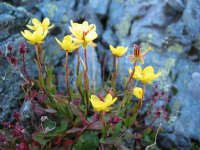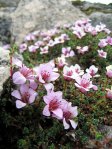Saxifraga l.
Family of Saxifrages - Saxifragaceae
Botanical characteristics. Perennial herbaceous plant.
Rhizome short, horizontal with subordinate numerous roots. Leaves are whole, elongated, sessile, lower - large, upper smaller. Flowers are single yellow or white. Medium flowers staminate. Blossoms in June - July, fructifies in July - August. Fruit is a box.
There are several species. The most common are:
- Sycamore marsh - S. hirculus L. Leaves rosette oblong-oval, pointed, narrowed into fairly long petioles, gradually decreasing. The stem is pubescent with red hairs. The flowers are white, about 1.5 cm in diameter.
Blooms in August. Seeds, as a rule, do not mature. Go under the snow in blossoming condition. But their immature seeds for the next year perfectly germinate. - Sinter saxifrage - S. oppositifolia L. It grows in high-altitude places. Leaves are rosette, thick, fleshy, often form thickets. Shoots are covered with narrow leathery leaves. Flowers purple or pink cup-shaped, single, relatively large. Blooms in early spring, right from under the snow.
Used parts of the plant. The medicinal raw material is the aerial part of the plant, less often the roots.
Chemical composition. The plant contains alkaloids, flavonoids, saponins, coumarins, vitamins, organic acids, glycosides, triterpene, higher fatty acids, essential oil, microelements, pigments, etc.
Application. The name of the plant "saxifrage" is attributed by some scientists to high-mountain species of stone blocks. They believe that they form cracks in the rocks. In addition, some authors believe that saxifrage is used in folk medicine to destroy kidney stones.
Preparations of saxifrage in the form of infusions and decoctions of the aerial part of the plant are used in folk medicine for gynecological diseases as hemostatic for various bleeding, laryngitis, pleurisy. In Transbaikalia - for the treatment of liver diseases, as an astringent; In Komi - in the treatment of heart disease, in combination with other plants in disorders of the gastrointestinal tract, lung diseases, as an analgesic. In some European countries, in the form of tincture and infusion of the aerial part, plants are used for urine and cholelithiasis, colitis; Externally - with jaundice, chronic rashes, for the treatment of skin diseases. Fresh juice is used to treat otitis, when lymph glands are denser.
In Tibetan medicine, saxifrage has found application in diseases of the bladder, liver, as an astringent, in gynecology, as wound healing, with conjunctivitis.
Interest in the plant grows due to the fact that in the foreign literature there is information about the antitumor activity of the plant.
Preparation. To get the infusion, take 20 g of the aboveground part of flowers, leaves or a mixture thereof, pour 200 ml of boiling water, insist on a boiling bath for 15 minutes, cool for 45 minutes, filter. Take 2 tbsp. Spoon 3-4 times a day after meals.





Comments
Commenting on, remember that the content and tone of your message can hurt the feelings of real people, show respect and tolerance to your interlocutors even if you do not share their opinion, your behavior in the conditions of freedom of expression and anonymity provided by the Internet, changes Not only virtual, but also the real world. All comments are hidden from the index, spam is controlled.